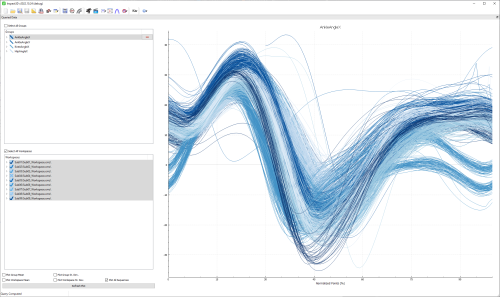Inspect3D Tutorial: Load and View Data
| Language: | English • français • italiano • português • español |
|---|
This tutorial begins by assuming that you have a CMZ file for each subject/session from Visual3D. If necessary you can work through the Visual3D tutorial for building a CMZ file.
Data
This tutorial can be completed with any CMZ file. One possibility is a data set from a Visual3D Workshop at a recent ASB meeting: V3D Workshop @ ASB.
Set the library path to the data directory
To start, you need to tell Inspect3D where to look for your data. After opening Inspect3D:
 Click the Load Library button on the toolbar to open the Library dialog:
Click the Load Library button on the toolbar to open the Library dialog:
- Click Browse to open a dialog that allows you to select a file path
- Select the top level folder/root directory which contains the CMZ files
- Click Select Folder
- Click Load
- Close the Library dialog
Define queries and group signals
Once you have loaded the library, the Group definition dialog will be activated. You now have the ability to automatically or manually define queries that will group the signals in your library. To do this:
- Click on the
 Group Definitions icon on the toolbar
Group Definitions icon on the toolbar - Click on
 Group Definitions to define group definitions for the first time and open the Group Definition Dialog OR
Group Definitions to define group definitions for the first time and open the Group Definition Dialog OR - Click on
 Load Group Def & Compute Groups to load a .q3d file containing queries and automatically calculate the groups for the open library.
Load Group Def & Compute Groups to load a .q3d file containing queries and automatically calculate the groups for the open library.
Once the Group Definition dialog is open there are two options for creating group definitions:
- Either manually create group definitions by
- OR Click Auto-Populate Groups
- Accept the default settings and click Create
Once you have created your group definitions:
- Click Calculate All Groups to apply the queries you have defined to the open library.
- Close the Group Definition dialog
- If Inspect3D has not finished computing all of the groups then it will ask you if you want it to continue. Click Compute Groups.
| Manually Create Group Definitions (Video) |
|---|
Visualize your data
Interact with your data
You can highlight a trace by left-clicking on it. This causes the trace to become more visually prominent than non-highlighted traces and produces a tooltip that includes:
- The trace's group name
- The trace's workspace name
- The name of the specific C3D file for that trace
- The trace's frame range from that C3D file
- The trace's sub-group name
- The x- and y- values of the trace where you left-clicked it
A trace can be excluded from the plot by:
- left-clicking on the trace to highlight it; then
- right-clicking and selecting Exclude > Exclude Trace (raw data) from the context menu.
You can confirm that the trace has been excluded in the Workspaces widget: excluded traces will be marked with a red X and workspaces containing excluded traces will have their checkmark icon replaced by an X.
| Manually View Group Definitions (Video) |
|---|
Save the application workspace
Click ![]() Save Workspace As to save the work you've done so far. This saves the application workspace as an .i3d file, which is an XML file.
Save Workspace As to save the work you've done so far. This saves the application workspace as an .i3d file, which is an XML file.
NOTE: If you have excluded data then your CMZ files are out of sync with your I3D workspace at this point, meaning that if you re-queried the data you would then need to exclude the traces again. To avoid this, click the ![]() Update CMZ files icon on the toolbar to update the CMOs at any point.
Update CMZ files icon on the toolbar to update the CMOs at any point.
